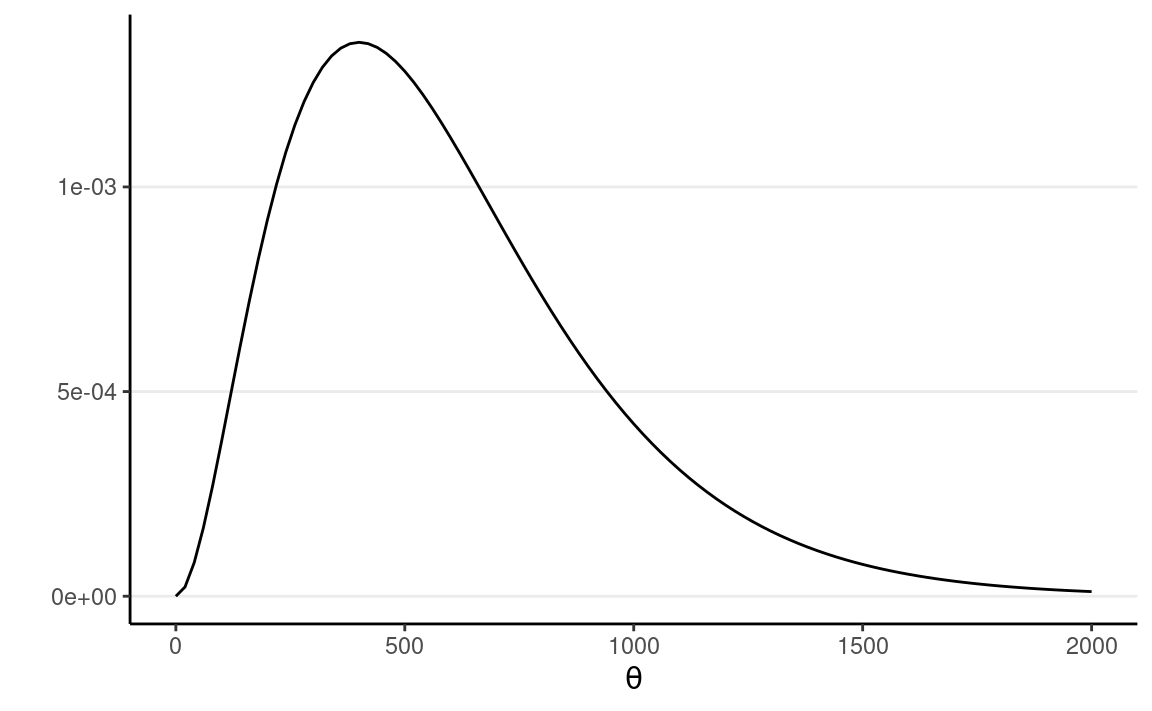Please note: This document uses count data on fatal police shootings.
library(psych)
library(tidyverse)
library(bayesplot)
library(posterior)
theme_set(theme_classic() +
theme(panel.grid.major.y = element_line(color = "grey92")))
I came across this data set from https://andrewpwheeler.com/2021/01/11/checking-a-poisson-distribution-fit-an-example-with-officer-involved-shooting-deaths-wapo-data-r-functions/
As explained here, the data are by the Washington Post in an effort to record every fatal shooting in the United States by a police officer since January 1, 2015.
Research Question
What’s the rate of fatal police shootings in the United States per year?
Data Import and Pre-Processing
# Import data
fps_dat <- read_csv(
"https://raw.githubusercontent.com/washingtonpost/data-police-shootings/master/fatal-police-shootings-data.csv"
)
We first count the data by year
# Create a year column
fps_dat <- fps_dat %>%
mutate(year = format(date, format = "%Y"))
# Filter out 2022
fps_1521 <- filter(fps_dat, year != "2022")
count(fps_1521, year)
#> # A tibble: 7 × 2
#> year n
#> <chr> <int>
#> 1 2015 994
#> 2 2016 958
#> 3 2017 981
#> 4 2018 985
#> 5 2019 999
#> 6 2020 1020
#> 7 2021 1054Poisson Model
Our interest is the rate of occurrence of fatal police shootings per year. Denote this as θ. The support of θ is [0,∞).
A Poisson model is usually a starting point for analyzing count data
in a fixed amount of time. It assumes that the data follow a Poisson
distribution with a fixed rate parameter: P(y∣θ)∝θyexp(−θ),
Choosing a Prior
The Gamma
distribution has support: [0,∞), and is a conjugate family to the Poisson model. The
Gamma distribution has the form P(θ)∝θa−1exp(−bθ),
Here’s a plot:
ggplot(tibble(th = c(0, 2000)), aes(x = th)) +
stat_function(fun = dgamma,
args = list(shape = 3, rate = 1 / 200)) +
labs(y = "", x = expression(theta))

Prior predictive check
set.seed(2200)
num_draws <- 100
sim_theta <- rgamma(num_draws, shape = 3, rate = 1 / 200)
# Initialize a time-series plot
ts_plot <- ggplot(count(fps_1521, year), aes(x = year, y = n))
# Simulate time series from the prior, and add to plot
# Initialize an S by N matrix to store the simulated data
y_tilde <- matrix(NA,
nrow = length(sim_theta),
ncol = 7)
colnames(y_tilde) <- 2015:2021 # add column names
for (s in seq_along(sim_theta)) {
theta_s <- sim_theta[s]
y_tilde[s,] <- rpois(7, lambda = theta_s)
}
# Convert to a data frame
y_tilde_df <- as_tibble(y_tilde) %>%
rownames_to_column(var = "id") %>%
pivot_longer(
cols = -id,
names_to = "year",
values_to = "y_tilde"
)
ts_plot +
geom_line(
data = y_tilde_df,
aes(y = y_tilde, group = id),
alpha = 0.3,
col = "skyblue"
) +
# add observed data
geom_point() +
geom_line(aes(group = 1))

Posterior
With a conjugate prior, the posterior distribution is Gamma(a + ∑Ni=1yi, b + N).
ggplot(tibble(th = c(0, 2000)), aes(x = th)) +
stat_function(fun = dgamma,
args = list(shape = 3 + nrow(fps_1521),
rate = 1 / 200 + 7), n = 501) +
labs(y = "", x = expression(theta))

Summary
Use simulation
num_draws <- 1000
post_theta <- rgamma(num_draws, shape = 3 + nrow(fps_1521),
rate = 1 / 200 + 7)
# Use the `posterior` package
posterior::as_draws(tibble(theta = post_theta)) %>%
summarize_draws()
#> # A tibble: 1 × 10
#> variable mean median sd mad q5 q95 rhat ess_bulk
#> <chr> <dbl> <dbl> <dbl> <dbl> <dbl> <dbl> <dbl> <dbl>
#> 1 theta 998. 998. 11.6 11.4 979. 1017. 1.00 1075.
#> # … with 1 more variable: ess_tail <dbl>So the estimated rate is 987 per year, with a 90% CI [967, 1006].
Posterior Predictive Check
# Initialize a time-series plot
ts_plot <- ggplot(count(fps_1521, year), aes(x = year, y = n))
# Simulate time series from the prior, and add to plot
# Initialize an S by N matrix to store the simulated data
y_tilde <- matrix(NA,
nrow = length(post_theta),
ncol = 7)
colnames(y_tilde) <- 2015:2021 # add column names
for (s in seq_along(post_theta)) {
theta_s <- post_theta[s]
y_tilde[s,] <- rpois(7, lambda = theta_s)
}
# Convert to a data frame
y_tilde_df <- as_tibble(y_tilde) %>%
rownames_to_column(var = "id") %>%
pivot_longer(
cols = -id,
names_to = "year",
values_to = "y_tilde"
)
ts_plot +
geom_line(
data = y_tilde_df,
aes(y = y_tilde, group = id),
alpha = 0.2,
col = "skyblue"
) +
# add observed data
geom_point() +
geom_line(aes(group = 1))
